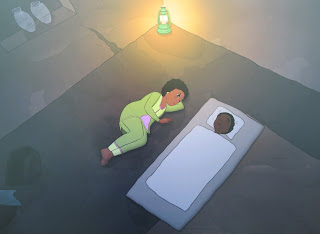Common misconceptions about Iran have prompted two curators to start their new exhibition ‘Iranian Women in Animation’ in Museum Arnhem. This collection confronts the audience with the difficult situation in Iran whilst accentuating and deepening their conceptions of Iranian culture. This exhibition tells various stories of Iranian women with the help of many impressive animations.
 |
| Courtesy Museum Arnhem. |
by Jet Bierkens & Victor Rikmenspoel, ANS
The ‘Iranian Women in Animation’ exhibition, curated by Narjes Mohammadi and Nahid Malayeri, contains ten animations that show a manifold of facets and stories, demonstrating the persistence and colourful diversity among Iranian artists. Every animation displays a different personal story that artistically tackles difficult topics, such as domestic violence, dress codes in school and forbidden love. Moreover, the short films, displayed in the white office-like room, contain various styles and subgenres of animation. This allows the viewer to immerse themselves in the world and experiences of Iranian women.
Universal or unique experiences?
All the way at the end of the museum is one room full of screens with headphones. Once you enter, you fall down a rabbit hole of Iranian culture. Sound and visuals work together to tell the unique story experienced by the director of the animation. At first glance, the stories seem to not have anything in common other than the fact that they are made by Iranian women. Nevertheless, all the short films have a deeper message: despite all the restrictions and obstacles that these women face -diverse as they may be- they all persevered and are able to show their incredible talents.
 |
| Illustration: Sarah Saidan. Courtesy ANS. |
When Narjes Mohammadi and Nahid Malayeri discuss the motivation behind the collection, Mohammadi states: ‘During our studies, we noticed that many people do not have a sound picture of Iran, and more specifically, artists in Iran.’ Malayeri adds: ‘A common misconception is that everyone speaks Arabic or that there is no technology in Iran.’ She passionately continues: ‘This ignorance has prompted us to show short animations in our university. We had the desire to show that we have so many great female artists in Iran. Not only did we want to introduce people here to these artists, but also introduce these humble artists to the animation industry.’
Furthermore, Mohammadi and Malayeri elucidate the selection process of the animations. ‘We went to numerous festivals in Iran, and, for the most part, we picked the animations with the highest quality’, Malayeri explains. ‘However, during the first screening in the Cavia Filmhouse, we noticed that most themes were quite dark and depressing. Then it became our goal to show a variety of themes in our collection, because what is happening in Iran is not just darkness, there is also light’, Malayeri explains. Mohammadi nods her head agreeingly and additionally emphasises that they wanted the animations to be based upon unique stories. ‘Some stories are very specific and personal, and therefore not a universal feeling that everyone can relate to. It is thus normal for the audience to have questions about the stories.’ She enthusiastically adds: ‘We want the audience asking questions and therefore learning about the rich and diverse stories of Iranian women.’
Twofold choices
Noticeable in the exhibition is the variety in methods and colours used in the animations. Where some films utilise bright colours and simplistic modern figures, other animations are ‘sketchy’ and ‘dark’. These gloomy films show a more pessimistic world, by exploiting less saturated colours and grim sounds. An instance of this can be found in the short movie That’s Mine! by Maryam Kashkoolinia. This film tells the story of residual landmines from after warfare that sometimes suddenly explode. The landmines are symbolic of war not stopping at the armistice, because the effects and threats still linger.
 |
| Illustration: Nahid Malayeri. Courtesy ANS. |
One of the most impressive movies, as also stated by the curators, was Our Uniform. This story is focused on clothing rules in Iranian schools. Malayeri explains the impact of the film for her personally: ‘The movie shows exactly how I felt when I was younger.’ She additionally states: ‘It was never explained why you had to wear those clothes. At that time I did not quite comprehend my emotions, but when I watched the movie, I felt heard.’ Mohammadi says she completely agrees: ‘It is only after the situation has ended that you realise how hard it was and how it actually impacted you.’
The curators illustrate the importance of personal stories when they talk about The Fourth Wall, an animation by Mahboobeh Kalaee. ‘The film is amazing’, Malayeri exclaims.‘The director herself is very humble and introverted, and I love that you can see that throughout the entire animation.’ Mohammadi adds whilst nodding: ‘It is very important for us that the animations are based upon personal stories of the directors. It takes courage to display such personal stories, but they also leave the biggest mark on a viewer.’
 |
| Illustration: Nahid Malayeri. Courtesy ANS. |
Artistically astonishing
Evidently, this exhibition bestows the audience with a new admiration for the artistic value of these Iranian artists. Not only do the stories told in the animations leave the visitors with plenty to ponder, they are also artistically astonishing. Every colour, line and sound has been carefully constructed to impress the audience. The ‘Iranian Women in Animation’ exhibition, a Collection of Voices and Stories, is a worthwhile visit and is still visible in museum Arnhem until the fifth of January.
Via ANS
 |
| Courtesy ANS. |

No comments:
Post a Comment